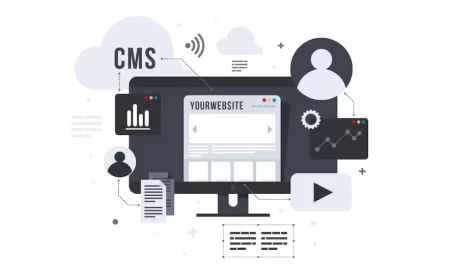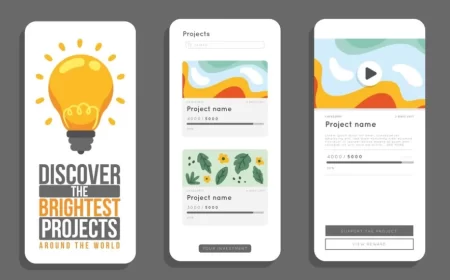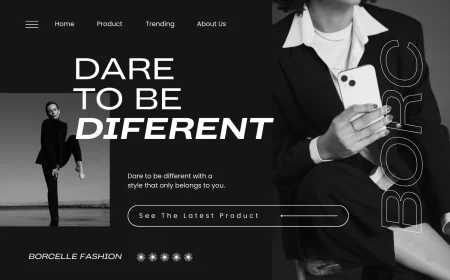In the fast-evolving digital landscape, a website is never truly “finished.” To remain relevant, competitive, and effective, periodic website redesigns are not just an option but a necessity. A redesign is more than just a fresh coat of paint; it’s a strategic opportunity to re-evaluate your digital presence, address user pain points, incorporate new technologies, align with evolving brand goals, and ultimately, improve your online performance.
Website redesign concepts are the strategic blueprints and creative visions that guide this transformative process. They involve a deep dive into current site performance, user behavior, market trends, and business objectives to formulate a new design that is not only aesthetically pleasing but also highly functional, conversion-optimized, and future-proof. Whether it’s a subtle refresh or a complete overhaul, a well-conceived redesign can significantly impact user engagement, SEO, brand perception, and revenue.
This comprehensive guide will explore the critical reasons for undertaking a website redesign, outline the fundamental phases of the redesign process, and delve into various conceptual approaches and modern design trends that can inform your strategy. We will provide a detailed breakdown of key elements to consider and offer descriptive examples of common redesign concepts, providing a wealth of inspiration and practical insights for revitalizing your digital presence.
Why Consider a Website Redesign?
Before diving into concepts, it’s crucial to understand the driving forces behind a redesign:
- Outdated Aesthetics & User Experience (UX): A visually stale or difficult-to-navigate website can deter visitors and damage brand credibility.
- Poor Performance: Slow loading times, non-responsive design, or broken functionalities lead to high bounce rates and frustrated users.
- Evolving Brand Identity: As a business grows or pivots, its website must reflect its current mission, values, and visual branding.
- Technological Advancements: New web technologies (e.g., AI integration, advanced animations, better CMS capabilities) offer opportunities for enhanced functionality and user engagement.
- Meeting Business Goals: The current website might not be effectively converting visitors into leads, sales, or desired actions. A redesign can optimize conversion paths.
- SEO & Mobile Responsiveness: Google prioritizes mobile-friendliness and Core Web Vitals. An outdated site can suffer in search rankings.
- Competitive Landscape: Competitors may have launched more modern, user-friendly websites, making your site appear less appealing.
- Content Management Issues: The existing CMS might be difficult to use, limiting content updates and scalability.
Phases of a Strategic Website Redesign
A successful redesign follows a structured process:
- Discovery & Strategy:
- Audit: Analyze current website performance (analytics, heatmaps, user feedback), identify pain points, and assess content.
- Goal Setting: Define clear, measurable objectives for the new website (e.g., increase conversions by X%, reduce bounce rate by Y%, improve organic traffic by Z%).
- Audience Research: Revisit or redefine target personas, their needs, and behaviors.
- Competitor Analysis: Evaluate competitors’ digital strategies and identify opportunities for differentiation.
- Content Strategy: Plan new content, update existing content, and map content to user journeys.
- Information Architecture (IA) & User Flows: Restructure site navigation and map out how users will move through the new site.
- Design & Prototyping:
- Wireframing: Create low-fidelity layouts to define structure and content placement.
- UI/UX Design: Develop high-fidelity mockups, applying brand guidelines, typography, color palettes, and visual elements.
- Prototyping: Create interactive prototypes to simulate user experience and gather feedback.
- User Testing: Validate design decisions with real users.
- Development & Implementation:
- Front-End Development: Coding the visual interface (HTML, CSS, JavaScript).
- Back-End Development: Building server-side logic, database integrations, and CMS setup.
- Content Migration: Moving existing content to the new platform.
- SEO Migration Plan: Crucial for preserving search rankings (301 redirects, sitemap updates).
- Launch & Post-Launch Optimization:
- Pre-Launch Checklist: Thorough testing, security checks, performance optimization.
- Launch: Go live!
- Monitoring: Continuously track performance (analytics, user behavior, errors).
- Iteration: Based on data and feedback, make ongoing improvements and optimizations.
Core Website Redesign Concepts & Approaches
Redesigns can range in scope and intensity. Here are common conceptual approaches:
-
The “Refresh” (Minor Redesign):
- Concept: Focuses on updating aesthetics and small UX improvements without major structural changes.
- Goal: Modernize look and feel, improve visual appeal, address minor usability issues.
- Example: Updating color palette, typography, imagery, refreshing hero sections, minor CSS tweaks.
- Ideal For: Brands with a solid foundation but a slightly dated appearance; limited budget/time.
-
The “Growth-Driven Design” (Iterative Redesign):
- Concept: Instead of a single, large overhaul, this approach involves continuous, smaller iterations based on data and user feedback. A “launch pad” site is built quickly, then refined over time.
- Goal: Minimize risk, get a new site live faster, ensure every change is data-backed, continuous improvement.
- Example: Launching with core pages, then adding features, optimizing conversions, and expanding content based on analytics.
- Ideal For: Businesses seeking agility, continuous improvement, and a data-driven approach.
-
The “Mobile-First Transformation”:
- Concept: Redesigning with the mobile user experience as the primary focus, then scaling up for larger screens.
- Goal: Optimize for mobile performance and usability, improve mobile SEO, cater to increasing mobile traffic.
- Example: Prioritizing mobile navigation, touch-friendly elements, responsive imagery, and streamlined content for small screens.
- Ideal For: Any business with significant mobile traffic or aiming for better mobile search rankings.
-
The “Content-Centric Redesign”:
- Concept: Re-architecting the site around its content, making information more discoverable, digestible, and engaging.
- Goal: Improve content consumption, establish thought leadership, boost SEO through content relevance.
- Example: Implementing a new blog display, advanced search/filtering, interactive content formats, and clear content hierarchies.
- Ideal For: Publishers, educational platforms, and businesses relying heavily on content marketing.
-
The “Conversion Optimization Redesign”:
- Concept: Focusing intensely on optimizing conversion paths, calls to action, and user flows to maximize desired outcomes (sales, leads, sign-ups).
- Goal: Increase revenue, improve lead generation, reduce cart abandonment.
- Example: A/B testing different CTA placements/colors, streamlining checkout processes, optimizing landing pages, improving form design.
- Ideal For: E-commerce stores, SaaS companies, and lead generation businesses.
-
The “Brand Alignment Redesign”:
- Concept: Overhauling the website to perfectly reflect a new or evolved brand identity, voice, and values.
- Goal: Strengthen brand perception, create a cohesive brand experience, differentiate from competitors.
- Example: Implementing a new logo, color palette, typography, imagery style, and brand messaging across the entire site.
- Ideal For: Companies undergoing rebranding, mergers, or significant strategic shifts.
-
The “Performance & Technical Overhaul”:
- Concept: Focusing primarily on improving site speed, technical SEO, and underlying code architecture.
- Goal: Enhance user experience, improve search engine rankings, reduce technical debt.
- Example: Migrating to a faster hosting, optimizing code, implementing lazy loading, improving Core Web Vitals, restructuring database.
- Ideal For: Sites with significant technical debt, slow load times, or poor SEO performance.
Modern Design Trends & Elements in Redesign Concepts
Successful redesigns often incorporate contemporary design trends to ensure a fresh and engaging experience:
- Minimalism & Whitespace: Clean layouts with ample negative space for clarity and focus.
- Bold Typography: Using unique and impactful fonts for headlines to create personality.
- Vibrant Color Palettes: Moving beyond safe neutrals to incorporate more expressive and contrasting colors.
- Asymmetrical Layouts: Breaking traditional grid structures for a more dynamic and artistic feel.
- Micro-interactions & Subtle Animations: Small, delightful animations that provide feedback and enhance user experience without being distracting.
- Immersive Hero Sections: Full-screen images or videos with compelling headlines to immediately grab attention.
- Dark Mode Toggle: Offering users the option to switch between light and dark themes for comfort and modern appeal.
- Custom Illustrations & Icons: Unique visual assets that reinforce brand identity and add personality.
- 3D Elements & WebGL: Incorporating interactive 3D models or environments for a cutting-edge experience.
- Glassmorphism/Neumorphism: Trendy UI styles (use with caution, ensure accessibility).
- Personalization: Delivering tailored content or experiences based on user behavior or preferences.
- Video Integration: Using background videos, explainer videos, and interactive video content.
- Accessibility First: Designing and developing with WCAG guidelines in mind from the outset.
- AI Integration: Leveraging AI for chatbots, personalized recommendations, content generation, or search.
Descriptive Examples of Website Redesign Concepts
Here are various conceptual approaches for website redesigns, detailing their focus and typical outcomes.
- The “Sleek SaaS Platform” Redesign
- Concept: Transform a cluttered SaaS website into a minimalist, high-performance platform with clean lines, ample whitespace, and intuitive navigation.
- Focus: Improved UX, clearer feature communication, faster load times.
- Key Elements: Large, compelling hero section with product video, benefit-driven headlines, subtle micro-interactions on feature blocks, clear pricing tables, integrated demo request forms.
- Outcome: Higher conversion rates for sign-ups/demos, enhanced brand perception as modern and efficient.
- The “Editorial Magazine” Redesign
- Concept: Revamp a traditional blog or content site into a visually rich, engaging online magazine experience.
- Focus: Content discoverability, readability, visual storytelling.
- Key Elements: Dynamic homepage grid featuring diverse content formats (articles, videos, podcasts), prominent featured articles, elegant typography, “read time” indicators, sticky social sharing buttons, interactive content filters.
- Outcome: Increased time on site, higher page views per session, stronger brand authority.
- The “Luxury E-commerce Experience” Redesign
- Concept: Elevate an online store from transactional to experiential, focusing on high-end visuals, immersive product showcases, and a seamless, premium shopping journey.
- Focus: Brand prestige, emotional connection, reduced cart abandonment.
- Key Elements: Full-screen lifestyle photography/video, sophisticated product carousels, detailed product pages with rich media, subtle animations on product details, streamlined checkout, integrated customer reviews with high visual impact.
- Outcome: Increased average order value, stronger brand loyalty, enhanced perceived value.
- The “Community-Driven Hub” Redesign
- Concept: Transform a static website into a vibrant, interactive platform that fosters user engagement and community building.
- Focus: User-generated content, interaction, sense of belonging.
- Key Elements: Prominent forums/discussion boards, user profiles, activity feeds, event calendars, easy content submission forms, gamification elements (badges, points).
- Outcome: Increased user retention, higher engagement rates, strong community growth.
- The “Data Visualization Powerhouse” Redesign
- Concept: Redesign a site that presents complex data into an intuitive, interactive, and visually compelling data visualization experience.
- Focus: Clarity of data, user exploration, actionable insights.
- Key Elements: Interactive charts and graphs, customizable dashboards, filterable datasets, clear explanations of methodologies, engaging infographics, responsive data displays.
- Outcome: Improved data comprehension, increased user trust, stronger reputation for data expertise.
- The “Personal Brand & Portfolio” Redesign
- Concept: Overhaul a personal website to be a dynamic, memorable showcase of skills, projects, and personality for freelancers or job seekers.
- Focus: Personal branding, project showcasing, lead generation.
- Key Elements: Unique hero section with a personal statement, interactive project case studies, clear “About Me” section with personality, prominent contact form, integrated blog for thought leadership, subtle scroll-triggered animations.
- Outcome: More inbound inquiries, stronger professional network, memorable online presence.
- The “Non-Profit Impact Story” Redesign
- Concept: Redesign a non-profit website to powerfully communicate its mission, impact, and foster donor engagement.
- Focus: Emotional connection, transparency, call for action (donations, volunteering).
- Key Elements: Compelling hero video/images of impact, clear mission statement, “Our Impact” section with statistics and stories, prominent donation buttons, volunteer sign-up forms, news/blog on current initiatives.
- Outcome: Increased donations, higher volunteer sign-ups, stronger public support.
- The “Educational Platform” Redesign
- Concept: Transform an online learning site into an intuitive, engaging, and accessible platform for students and educators.
- Focus: Learning experience, course discoverability, user progress tracking.
- Key Elements: Clear course catalogs with filtering, engaging course landing pages, interactive lesson previews, student dashboards, progress trackers, integrated quizzes/assessments.
- Outcome: Higher course completion rates, improved student satisfaction, increased enrollments.
- The “Restaurant & Hospitality” Redesign
- Concept: Revamp a restaurant or hotel website to evoke ambiance, showcase offerings, and streamline reservations/bookings.
- Focus: Visual appeal, ease of booking, menu/service presentation.
- Key Elements: High-quality food/interior photography, immersive background videos, clear menu displays, integrated online reservation system, virtual tours, customer testimonials.
- Outcome: Increased reservations, higher online orders, enhanced brand perception.
- The “Green & Sustainable Brand” Redesign
- Concept: Design a website that visually embodies environmental consciousness and promotes sustainable products or services.
- Focus: Eco-friendly messaging, transparency, community impact.
- Key Elements: Earthy color palettes, nature-inspired imagery/illustrations, clear information on sustainable practices, carbon footprint calculators, impact reports, prominent eco-certifications.
- Outcome: Stronger alignment with eco-conscious consumers, increased brand trust, higher engagement with sustainability initiatives.
- The “Interactive Product Configurator” Redesign
- Concept: For a product with many customization options, redesign the website to feature an intuitive, real-time product configurator.
- Focus: Personalization, visualization, simplified ordering.
- Key Elements: 3D product viewer, real-time visual updates on customization choices (colors, materials, features), clear pricing adjustments, “add to cart” directly from configurator.
- Outcome: Higher conversion rates for customized products, reduced customer confusion, enhanced user engagement.
- The “Event & Conference” Redesign
- Concept: Transform an event website into a dynamic hub for information, registration, and attendee engagement.
- Focus: Clear event details, easy registration, speaker/agenda showcase.
- Key Elements: Countdown timer, prominent “Register Now” CTA, speaker profiles with photos and bios, detailed agenda with filtering, venue information, sponsor showcase, social media integration.
- Outcome: Increased registrations, improved attendee experience, stronger sponsor satisfaction.
- The “Real Estate Property Showcase” Redesign
- Concept: Redesign a real estate website to beautifully showcase properties with immersive visuals and detailed information.
- Focus: Visual appeal of properties, detailed listings, lead capture.
- Key Elements: High-resolution photo galleries, virtual tours (3D/video), interactive floor plans, detailed property descriptions, neighborhood guides, integrated contact forms, mortgage calculators.
- Outcome: More qualified leads, faster property sales, enhanced brand reputation.
- The “Membership Site” Redesign
- Concept: Overhaul a membership-based website to highlight member benefits, streamline sign-up, and provide an engaging member-only experience.
- Focus: Value proposition for members, easy access to content, community.
- Key Elements: Clear “Join Now” CTA, breakdown of membership tiers and benefits, member testimonials, sneak peeks of exclusive content, streamlined sign-up flow, intuitive member dashboard.
- Outcome: Increased membership conversions, higher member retention.
- The “AI-Powered Service” Redesign
- Concept: Design a website for an AI-driven product or service that clearly explains complex AI capabilities in an accessible and engaging way.
- Focus: Demystifying AI, showcasing benefits, building trust.
- Key Elements: Interactive demos of AI in action, clear use cases, simplified explanations of AI concepts, engaging illustrations, ethical AI statements, prominent “Try Demo” or “Get Started” CTAs.
- Outcome: Increased understanding and adoption of AI services, enhanced credibility.
Conclusion: A Strategic Investment in Your Digital Future
A website redesign is a significant undertaking, but when approached strategically with clear concepts and objectives, it becomes a powerful investment in your digital future. It’s an opportunity to:
- Reinvigorate your brand and align it with current market perceptions.
- Enhance user experience and directly address customer needs.
- Leverage new technologies for improved performance and functionality.
- Optimize for business goals, driving higher conversions and revenue.
- Strengthen your SEO and maintain competitive relevance.
By considering these diverse website redesign concepts and the modern design trends that shape them, you can develop a comprehensive strategy that transforms your online presence from merely functional to truly exceptional, ensuring it remains a dynamic and effective asset for years to come.












